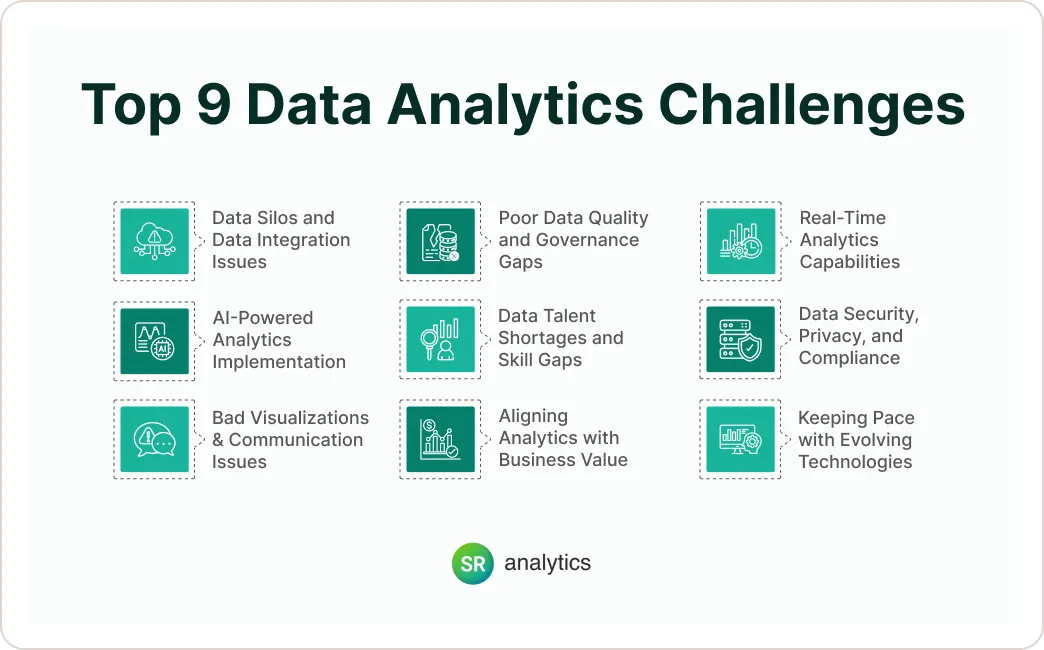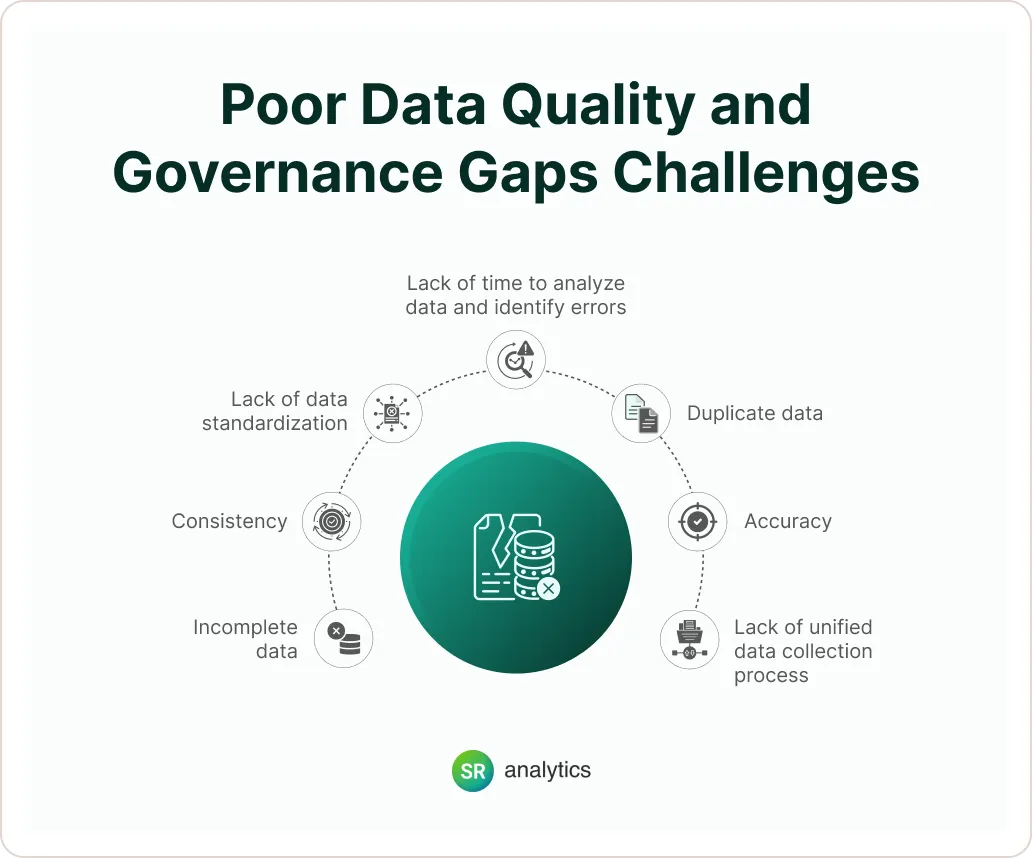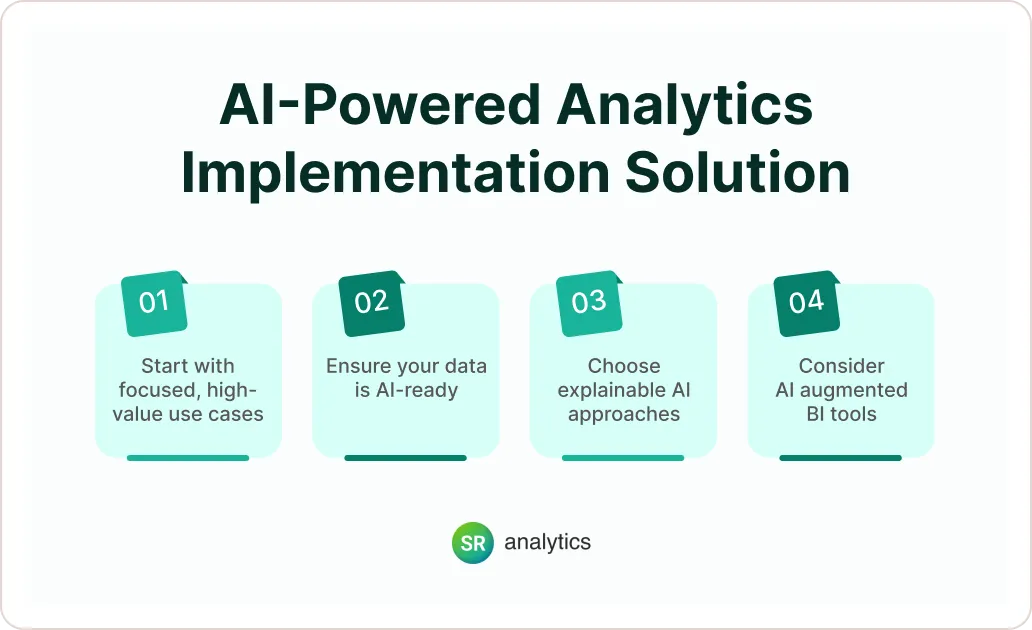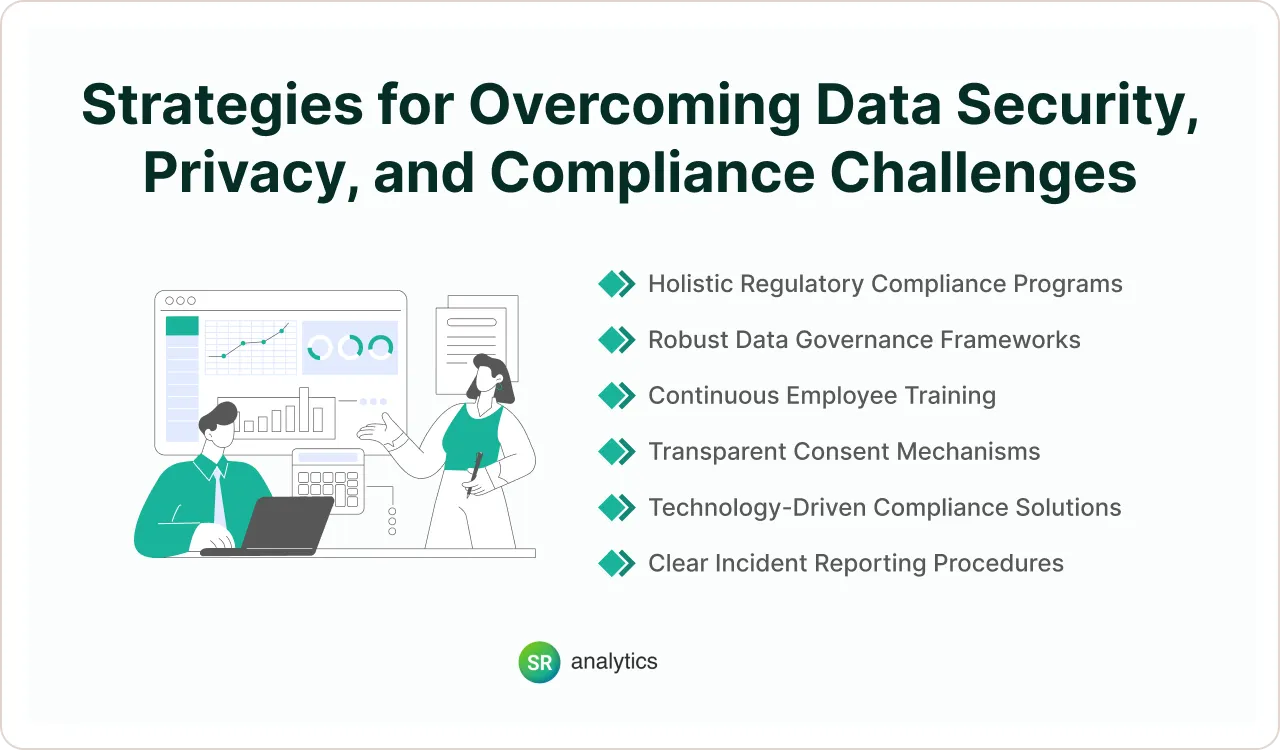Introduction
We’re drowning in data but starving for insights.
If you’ve felt this way about your organization’s data analytics efforts, you’re not alone. In 2025, the global data analytics market is projected to exceed $82.23 billion to USD 402.70 billion by 2032, yet many businesses continue to struggle with transforming their mountains of data into actionable business intelligence.
I’ve spent years working with companies across industries, and I’ve noticed a pattern: despite significant investments in fancy dashboards and powerful business intelligence (BI) tools, many organizations still face fundamental data analytics challenges that prevent them from becoming truly data-driven.
In this guide, I’ll walk you through the nine most common data analytics challenges businesses face in 2025 and—more importantly—provide practical data analytics solutions you can implement starting today.

Challenge #1: Data Silos and Data Integration Issues
The Problem
Picture this: your marketing team uses one system for campaign data, sales has their CRM, customer service tracks interactions in another platform, and finance maintains their own records. Sound familiar?
Data silos remain one of the most persistent obstacles in analytics. When information is fragmented across different systems, you’re left with an incomplete picture that makes meaningful analysis nearly impossible.
According to research, data integration issues are among the top data analytics challenges businesses face. These include “organizational silos that hinder collaboration” and “complexity in selecting and integrating analytics technologies.”
The Solution
1. Map your data ecosystem
Before you can solve data integration issues, create a comprehensive inventory of all your data sources, including what data lives where, who owns each system, and which data elements are most valuable for analysis.
2. Implement a centralized data architecture
- Data warehouse: Traditional but reliable for structured data
- Data lake: Better for large volumes of unstructured data
- Data lakehouse: A hybrid combining the best of both
- Data fabric: Advanced architecture connecting distributed sources
For most mid-sized businesses, a cloud-based data warehouse offers the best balance of power and usability when addressing data integration issues.
3. Standardize data formats and definitions
Create a “single version of the truth” by establishing consistent naming conventions, standard formats, and clear definitions for key metrics.
🔍 Pro Tip: Start small by integrating your two most valuable data sources, prove the value, then expand your integration efforts systematically.
Challenge #2: Poor Data Quality and Governance Gaps

The Problem
Bad data leads to bad decisions—it’s that simple.
Poor data quality is a persistent challenge as organizations consistently make critical business decisions based on data that’s inaccurate, incomplete, or inconsistent. According to Gartner, poor data quality costs organizations an average of $12.9 million annually.
Research shows that data quality and governance are considered the top data analytics challenges in current analytics environments.
The Solution
1. Establish data governance best practices
- Assign ownership: Designate data owners for key data domains
- Create a data catalog: Document what data you have and what it means
- Develop policies: Establish standards for data collection and retention
- Implement review processes: Regular reviews ensure policies are followed
Data governance best practices ensure proper management, quality, security, and accessibility of data within an organization.
2. Implement quality at the source
- Add validation rules to data entry forms
- Provide clear guidelines and training for anyone inputting data
- Automate data capture where possible to reduce human error
3. Create a data quality culture
- Educate stakeholders on the importance of data quality
- Make data quality metrics visible to everyone
- Include data quality responsibilities in job descriptions
🔍 Pro Tip: Create a data quality scorecard with key metrics and share it regularly with leadership to maintain focus on this critical area.
Challenge #3: Real-Time Analytics Capabilities
The Problem
In today’s business environment, waiting days—or even hours—for insights is often too late.
The rise of real-time commerce, social media, and IoT devices has created demand for immediate insights. Traditional batch processing approaches now leave businesses at a competitive disadvantage.
In 2025, businesses are no longer asking if they need increased access to business intelligence tools, but what is the best BI solution for their specific needs.
The Solution
1. Identify your true real-time needs
- Fraud detection
- Website personalization
- Supply chain monitoring
- Customer service optimization
- Performance marketing optimization
2. Implement streaming data architecture
- Adopt streaming platforms like Apache Kafka or Amazon Kinesis
- Implement stream processing frameworks
- Create data pipelines designed for continuous data flow
3. Use edge computing where appropriate
Processing data closer to its source reduces latency and helps solve “common challenges of on-premise data centers, like bandwidth limitations, unexpected network disruptions, and latency issues.
🔍 Pro Tip: Start with a limited real-time analytics pilot focusing on one high-value use case to demonstrate value before expanding.
Challenge #4: AI-Powered Analytics Implementation
The Problem
AI promises to revolutionize analytics, but many organizations struggle to move beyond the hype.
The real challenge is implementing AI-powered analytics tools effectively when data isn’t prepared for AI applications, technical teams lack expertise, and concerns exist about AI bias and explainability.
Research indicates that “the increased integration of AI and big data comes with challenges, including data governance, AI model management and the need for responsible and ethical AI.
The Solution

1. Start with focused, high-value use cases
- Clearly defined problems where AI-powered analytics tools can deliver measurable value
- Use cases with sufficient historical data available
- Problems that are too complex for traditional analytics
Churn prediction, demand forecasting, and anomaly detection are often good starting points.
2. Ensure your data is AI-ready
- Clean and preprocess data before attempting AI projects
- Ensure sufficient volume and variety of training data
- Address potential biases in historical data
3. Choose explainable AI approaches
- Models that provide visibility into decision factors
- Tools that can explain predictions in business terms
- Approaches that enable human oversight and intervention
4. Consider AI-augmented business intelligence tools
- Generate natural language explanations of data trends
- Automatically identify anomalies and patterns
- Create visualizations based on verbal or written requests
🔍 Pro Tip: Document your AI models and processes thoroughly from the beginning—this will save countless hours as your AI initiatives scale.
Challenge #5: Data Talent Shortages and Skill Gaps
The Problem
The demand for data talent continues to outpace supply in 2025.
Research shows that “common challenges include difficulty recruiting specialized talent, organizational silos that hinder collaboration, complexity in selecting and integrating analytics technologies”.
The shortage is particularly acute for professionals who combine technical skills with business acumen—those who can translate data into strategic recommendations.
The Solution
1. Develop internal talent pipelines
- Identify analytically-minded people across your organization
- Create learning paths with structured training and mentoring
- Provide hands-on project experience with increasing responsibility
2. Implement a comprehensive data literacy program
- Develop role-specific data literacy curricula
- Create a common data vocabulary across the company
- Train managers on how to use data in decision-making
3. Leverage no-code/low-code business intelligence tools
- Deploy self-service business intelligence tools for business users
- Implement drag-and-drop data preparation tools
- Use AI-powered assistants to guide non-technical users
🔍 Pro Tip: Create a “data dojo” where employees can practice analytics skills on real business problems in a supportive environment with expert coaching.
Challenge #6: Data Security, Privacy, and Compliance
The Problem
As analytics capabilities grow, so do security and compliance requirements.
Organizations face increasing risks around how they collect, store, analyze, and share data. Enhanced data governance best practices are becoming non-negotiable, as “businesses must prioritize robust governance practices to foster trust and transparency”.
The Solution

1. Implement comprehensive data security
- Access controls: Implement role-based access following least-privilege principles
- Encryption: Protect data both in transit and at rest
- Monitoring: Deploy systems to detect unusual access patterns
2. Build privacy by design
- Data minimization (collect only what you need)
- Purpose limitation (use data only for intended purposes)
- Anonymization and pseudonymization where appropriate
3. Train all employees on security and privacy
- Regular security awareness training
- Role-specific privacy training
- Clear incident reporting procedures
🔍 Pro Tip: Create a data classification system that clearly identifies sensitive data elements and applies appropriate controls automatically based on classification level.
Challenge #7: Bad Visualizations and Communication Issues
The Problem
Even the most sophisticated analysis is worthless if decision-makers can’t understand it.
Bad visualizations can affect your company in several ways, including waste of valuable resources when stakeholders spend additional time questioning and seeking clarification.
The Solution
1. Design with the end user in mind
- Executives: High-level KPIs with clear trends and exceptions
- Managers: Operational metrics with actionable details
- Analysts: Detailed views with exploration capabilities
2. Follow visualization best practices
Ask yourself: “Which format will help communicate the data in the clearest manner possible?” A pie chart that compares too many variables, for example, will likely make it difficult to see the differences between values.
- Choose appropriate chart types for the data and message
- Use color purposefully and consistently
- Minimize chart junk and decorative elements
- Provide context and clear labeling
3. Focus on insights, not just data
- Highlight key findings and anomalies
- Provide written narratives alongside visualizations
- Include contextual information and benchmarks
- Suggest potential actions based on the data
🔍 Pro Tip: For any important dashboard, create a 30-second “how to read this” video that users can watch to quickly understand how to get value from the visualization.
Challenge #8: Aligning Analytics with Business Value
The Problem
Too many analytics initiatives fail to deliver clear business impact.
Research indicates that data governance initiatives often fall short of expectations when they “don’t align with business strategies, leading to outdated data and inefficient decision-making”.
The Solution
1. Start with business problems, not data
- Identify specific decisions that need to be made
- Define measurable outcomes you want to achieve
- Establish how improved insights would change actions
2. Implement outcome-focused metrics
- Define KPIs that reflect business outcomes, not just analytics outputs
- Create a clear link between analytics insights and business metrics
- Track both leading indicators and lagging outcomes
3. Establish a value realization process
- Document baseline metrics before implementing analytics
- Track decisions made based on analytics insights
- Quantify the impact of those decisions
- Share success stories across the organization
🔍 Pro Tip: For each major analytics initiative, create a one-page “value case” that clearly articulates the business problem, the analytics solution, expected outcomes, and how success will be measured.
Challenge #9: Keeping Pace with Evolving Technologies
The Problem
The analytics technology landscape evolves at a dizzying pace.
By 2025, the analytics technology landscape is expected to be driven by AI, machine learning, NLP, data mesh, edge computing, and cloud technologies, enabling “faster processing, improved insights, and wider data accessibility”.
The Solution
1. Develop a technology roadmap
- Assess your current capabilities and gaps
- Research emerging technologies and their potential impact
- Prioritize investments based on business value and feasibility
2. Implement modular architecture
- Use APIs and microservices to enable component replacement
- Adopt standards that facilitate interoperability
- Separate data storage from processing and visualization layers
3. Balance build vs. buy decisions
- Assess vendor solutions against your requirements
- Consider total cost of ownership, not just purchase price
- Evaluate integration capabilities and vendor lock-in risks
🔍 Pro Tip: Create a dedicated innovation sandbox environment where teams can experiment with new business intelligence tools and technologies without risking production systems.
Conclusion: Building a Data-Driven Future
The nine data analytics challenges we’ve explored represent the most common obstacles organizations face on their data analytics journey in 2025. While these data analytics challenges may seem daunting, each has proven data analytics solutions that you can implement regardless of your organization’s size or analytics maturity.
Remember that becoming truly data-driven is a journey, not a destination. Start by addressing your most pressing data analytics challenges, measure your progress, and continuously adapt your approach as technologies and business needs evolve.
In 2025, “data and analytics are expected to be the backbone of digital transformation”, with the global market exceeding $82.23 billion. By systematically addressing these data analytics challenges & solutions, you’ll be well on your way to unlocking the full potential of your data and analytics investments.
What data analytics challenges is your organization facing? I’d love to hear about your experiences in the comments below.














